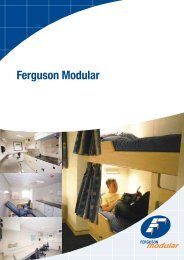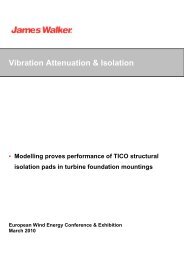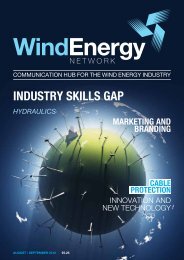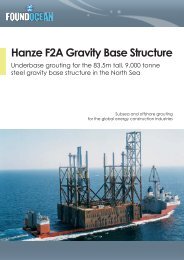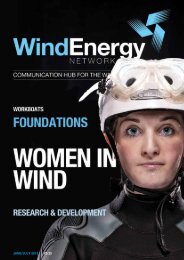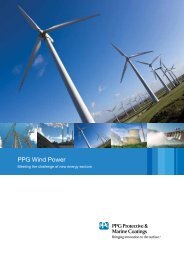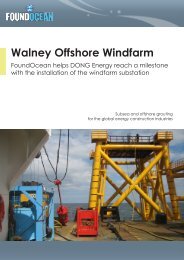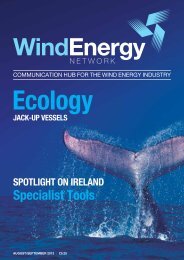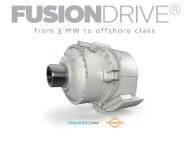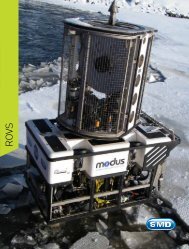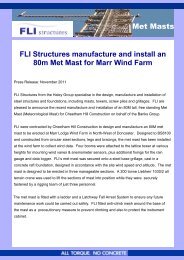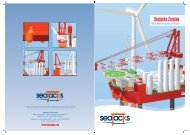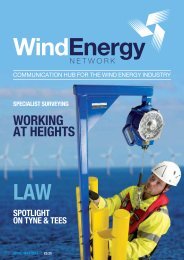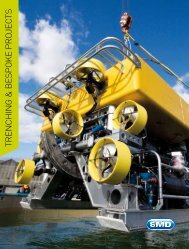UNEXPLODED ORDNANCE - Wind Energy Network
UNEXPLODED ORDNANCE - Wind Energy Network
UNEXPLODED ORDNANCE - Wind Energy Network
You also want an ePaper? Increase the reach of your titles
YUMPU automatically turns print PDFs into web optimized ePapers that Google loves.
SPONSORS OF STEEL FOUNDATIONS<br />
Tata steel<br />
increases efficiency<br />
of offshore wind farm<br />
jacket construction<br />
Offshore wind turbines are<br />
playing an ever-increasing<br />
role in governments’ aims<br />
to continue transitioning to<br />
a low-carbon economy and<br />
meet stated green aims by<br />
2020. Renewable energy is one<br />
of the most cost effective<br />
methods of producing power<br />
in the long run, once the<br />
capital costs of the initial<br />
design, manufacture, assembly<br />
and installation have been<br />
reconciled.<br />
Commitment<br />
The UK is committed to producing 15%<br />
of its energy from renewable sources<br />
by 2020 and to meet this demand,<br />
manufacturers are continuously striving<br />
to produce wind turbines with increasing<br />
power outputs. <strong>Wind</strong> farms are being<br />
developed in larger numbers, deeper<br />
waters, further offshore and therefore<br />
almost inevitably requiring a move away<br />
from monopile construction to other<br />
alternative foundation structures.<br />
Experience and technical<br />
expertise<br />
With a long-standing presence and<br />
significant technical expertise in the<br />
burgeoning global<br />
renewable energy and<br />
power sector, Tata Steel<br />
has reviewed the factors<br />
affecting the structural<br />
design of offshore wind<br />
turbine platforms, a<br />
significant part of the initial<br />
capital expenditure and has<br />
invested in new routes to<br />
support economical serial<br />
jacket production.<br />
Current factors affecting<br />
the structural design of any<br />
wind turbine include…<br />
• The desire to improve<br />
the power output for each turbine<br />
to enable enhanced return on<br />
investment, leading to increased size<br />
and weight and enhanced structural<br />
stress and fatigue.<br />
• Design guidelines based on offshore<br />
oil and gas installations<br />
• <strong>Wind</strong> turbines being located further<br />
offshore in deeper waters<br />
• Challenging government targets for the<br />
cost per megawatt-hour (MWh)<br />
• Small wind farm developments are<br />
being replaced with multi stage large<br />
farms<br />
Providing cost effective<br />
solutions<br />
With stretching targets for cost per<br />
kilowatt-hour (KWh) having been set,<br />
Tata Steel has looked at how to minimise<br />
all the incidental costs including that of<br />
manufacturing, installing and maintaining<br />
the structure of an offshore wind turbine<br />
and there are several key factors to<br />
consider, in order to achieve cost effective<br />
solutions.<br />
Design and assembly standardisation<br />
will be important in ensuring economies<br />
of scale within the sub supply chain.<br />
Small deviations from manufacturers<br />
optimised steel tube sizes have been<br />
adding significant additional costs. Close<br />
collaboration between the designer,<br />
fabricator and steel supplier will be<br />
required to ensure design integrity is<br />
optimised while maximising process<br />
efficiency and minimising costs.<br />
Displacing the current supply of the bundle<br />
of individual tubes by steel suppliers with<br />
complete point-to-point assemblies will<br />
enhance fabricator throughput. Painted<br />
assemblies incorporating pre-prepared<br />
machined ends will enable swift assembly<br />
and welding by fabricators.<br />
Tube manufacturing for<br />
offshore structures<br />
There are three primary methods<br />
for manufacturing tubes for offshore<br />
structures; three roll bending, JCO and<br />
UOE, the latter two indicating the shape<br />
during forming. In all cases submerged arc<br />
welding is the preferred option with both<br />
high production single pass welding and<br />
multi pass welding being adopted.<br />
• Three roll bending<br />
Three roll bending has been the traditional<br />
method of producing large diameter three<br />
to four metre cans welded for use in<br />
monopiles. It is a very flexible process<br />
with unconstrained diameters available<br />
and immense quantity flexibility, however<br />
it has a very slow throughput rate. High<br />
production volumes are being considered<br />
for developing wind farms and utilising this<br />
option for legs and braces is unlikely to be<br />
economic.<br />
40<br />
www.windenergynetwork.co.uk



